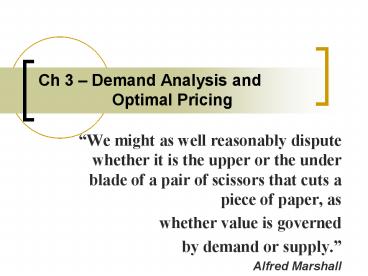Ch 3 Demand Analysis and Optimal Pricing PowerPoint PPT Presentation
1 / 14
Title: Ch 3 Demand Analysis and Optimal Pricing
1
Ch 3 Demand Analysis and Optimal Pricing
- We might as well reasonably dispute whether it
is the upper or the under blade of a pair of
scissors that cuts a piece of paper, as - whether value is governed
- by demand or supply.
- Alfred Marshall
- (1842-1924)
2
The Demand Function
Example Q f(P1, P2, Y)
Quantity (Q) is a function of (depends on the
value of) the price of the good (P1), the price
of related goods (P2) and income (Y).
3
The Demand Function
Q 25 3Y P2 2P
These explanatory variables (determinants of
demand) are the things held constant with the
ceteris paribus assumption. Plugging in values
for the determinant variables give us the demand
function in the form we recognize (example, Q
622 2P)
4
Determinants of Demand
- Income
- Normal goods (Y increase, demand increase)
- Inferior goods (Y increase, demand decrease)
- Price of related goods
- Substitute goods (P increase, demand increase)
- Complementary goods (P increase, demand
decrease) - Population changes
- ex, baby boomers
5
Elasticity of Demand (3 types)
Price elasticity Responsiveness of quantity
demanded to changes in price.
6
Price Elasticity of Demand
Ratio of the percentage change in quantity and
percentage change in a goods price, ceteris
paribus.
7
Price Elasticity of Demand
Point elasticity vs arc elasticity
8
Price Elasticity of Demand
EP -1 Unitary (Unit) Elastic Price and
quantity demanded change by same percentage, but
in opposite directions.
9
Price Elasticity of Demand
EP -1 Unitary (Unit) Elastic
-1 lt EP lt 0 Inelastic Percentage change in
quantity is less than the percentage change in
price.
10
Price Elasticity of Demand
EP -1 Unitary (Unit) Elastic
-1 lt EP lt 0 Inelastic
EP lt -1 Elastic Percentage change in quantity is
greater than the percentage change in price.
11
Price Elasticity of Demand
P
Perfectly Inelastic EP 0 Quantity does not
change as price changes.
Q
12
Price Elasticity of Demand
P
Perfectly Elastic EP - Price does not change
as quantity changes.
8
Q
13
Factors Affecting Price Elasticity
Is the good a necessity? Necessities tend to be
relatively inelastic.
Are there substitutes? When there are few
substitutes, demand for good tends to be
relatively inelastic.
What of income is spent on good? Lower of
income spent on good, demand tends to be
relatively inelastic
How much time to adjust to price change? Less
time to adjust, good tends to be relatively
inelastic. Becomes more elastic as time passes
and adjustments made.
14
Elasticity of Demand (3 types)

